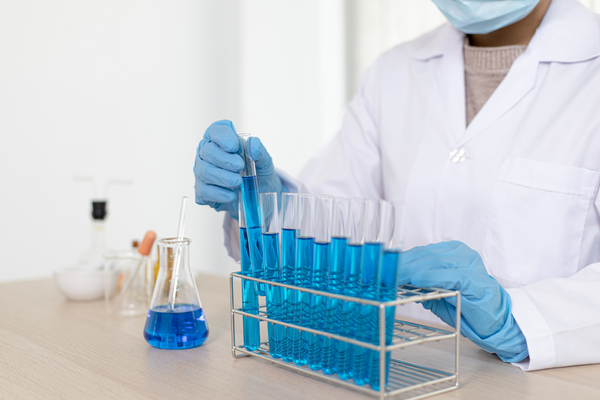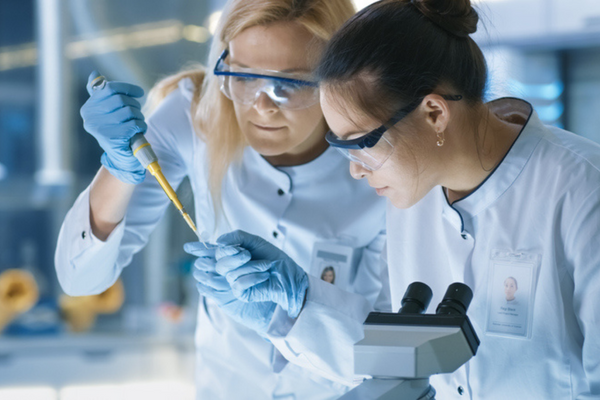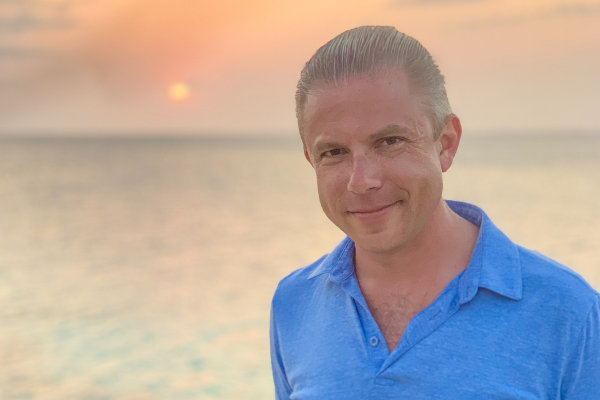
What’s the best career decision you ever made? What prompted it? What would have happened had you not made it?
Without a doubt, the best career decision I made was to leave the Navy at the end of 1988. I was definitely on an “upward trajectory” in my naval career, but I saw a future that was dark and would have cost me my family should I have chosen to stay in. That price was too high for me to pay; and I recognized that even in my late 20s. Likewise, the naval career path at the time would have taken me away from the thing that I loved most about the nuclear navy – operational engineering.
What do you know more about at this point in your career: Chemistry, or running a small business?
That’s a bit of a loaded question. Both “chemistry” and “business” are very broad and I certainly don’t know everything there is to know about either. It helps that I have a deep network of professional colleagues that I can turn to when I have questions about either chemistry or business.
With respect to chemistry, part of what I do in my daily work is to evaluate chemical operations for safety. That requires a deep understanding of the fundamentals, primarily of thermodynamics and energy transfer. Controlling energy is a big part of chemical safety. I do that quite well. I do not push electrons in SN1 or SN2 reactions well at all, but I do know where to look for the information.
Regarding business, I am mature enough to understand that I don’t know enough. With respect to the legalities of business management, I have a good accountant and a good lawyer. When it comes to marketing and advertising, however, I’m terrible and I know it. However, being a solid chemist, industrial hygienist and project manager who can find practical solutions to complex safety challenges, it appears I have overcome my lack of marketing and advertising skills. Having a thick Rolodex has helped too!
Most rewarding part of being an entrepreneur? Least rewarding?
The best part: I wake up every morning gainfully unemployed. There is a certain exhilaration the whole situation brings. Right up there with the best part is that I am intellectually challenged with every project and in some instances (with long-term clients) I can see improvement in their safety processes.
The least rewarding is probably some of the drudge of “office” stuff that comes with every job.
What was the pivotal point in your life when you made the commitment to try being an entrepreneur?
I made the commitment to full-time consulting in December 2012. My colleague and mentor, Dr. Neal Langerman, and I had just finished a job overseas and I was onboard a 777, in business class sipping champagne at 9AM realizing that I had just completed the most scientifically challenging and personally rewarding project that I had worked since I had left the Navy. I got off the plane in St. Louis, and told my wife that “sometime in 2013, we’ll be on our own.” I walked away from traditional employment in September 2013.
For chemists who think they may have an entrepreneurial mindset, how should they proceed?
In a word: Carefully. First and foremost, they need to do a “gut check” to see if they have the constitution for the stress of not knowing when your next paycheck will arrive. If they are married, the spouse needs to be 100% on-board as well. Next, and almost as important, they must have every aspect of their finances in order. This means that one simply must have two years of personal living expenses plus an emergency fund, preferably in cash. For me, personally, I knew that I would leave traditional employment at some point, so my family and I were saving towards that goal. We accelerated that savings when I got off the plane in St. Louis and hit the goal in mid-August 2013. I put in my two-week notice and the rest, as they say, is history.
There appears to be a greater focus on chemical safety in academia and industry. Do you agree? And if so, what’s behind it?
The categories, “industry” and “academic” are far too broad to be well-discussed. Allow me to make narrowing distinctions within the categories of “industry” and “academic.” Let’s first make the cut between industrial research activities and industrial production activities. Likewise, we need to cut “academic” into large, Ph.D.-granting universities and small, primarily undergraduate instruction colleges.
Keep in mind that there have always been solid safety programs in both academic (large and small) and in industry (research and production) settings. Likewise, there have always been, shall we say, “less than adequate,” programs across the distinctions. It would be incorrect to categorically state that “academic safety has been bad” and “industrial safety has been good.”
With that, there has been a noticeable emphasis on academic chemical safety since the Sheri Sangji (UCLA) and Michele Dufault (Yale) fatalities and the Texas Tech University incident. I remain committed to commentary that I’ve made in the past that it was not the incidents themselves that raised awareness – it was the felony manslaughter indictment of Patrick Harran after the Sheri Sangji fatality that raised awareness across the board. It was at that moment in chemical safety history that the academic enterprise was held to the same standard as their industrial counterparts. It shocked academia out of their lethargy with respect to safety.
The lessons from the UCLA fatality and TTU incident were not lost on industry. To paint with a very broad brush, industry tends to learn from other people’s incidents, especially high-consequence incidents like UCLA and TTU. They very much have a “It is better to learn from a horrible example than to be one” mindset, driven primarily by profit and reputation. My industrial clients started paying a lot of attention to energetic material shortly after those incidents and have incorporated appropriate controls where necessary. Academia, in general, is slower to learn from others.
I think that we’re seeing improvement in safety due, in part, to generational change. Those individuals who were impacted a decade ago are now in both sets of workforces. Likewise, there has been noticeable academic-industrial cooperation with respect to safety which has led to groups like “Joint Safety Teams” at many universities.
There is a cautionary tale in this as well. We are now roughly a decade out from the UCLA, Yale, and TTU incidents. I’ve noticed in my travels that people are becoming complacent regarding safe work practices again. As I teach workshops across the country, I am now coming across those that have not heard of the incidents at UCLA, Yale, TTU or even the University of Hawaii. I fear that we may be losing our institutional memory, and that will be to the detriment of us all.
What are some of the more egregious safety violations you have personally witnessed in your career?
I can think of two, and neither of them were “chemical-safety” incidents; they were both classified as “occupational safety.”
The first was a confined space incident that resulted in one fatality and one near miss. I was part of the investigation team. Had the team and their supervisor followed mandated confined space protocols, the incident would not have occurred. The regulations governing confined space operations are both well-known and relatively simple to follow. I have a low tolerance for failing to follow proper protocols governing confined space entry.
The second was a heat-stress incident that resulted in a case of heat stroke. Like with many heat-related incidents, the incident progressed from “I’m OK” to “I’m feeling woozy” to “on the ground” very quickly. The crew didn’t recognize early heat-stress symptoms and didn’t take appropriate action to get the individual cooled off before the patient was in trouble. Thankfully, emergency medical services were relatively close to the job site and they were able to get the individual to the hospital quickly.
How did your parents influence your leadership style?
I don’t think my parents had a great deal of influence on my “leadership style” per se. My father was a 40-year blue collar machine repairman for Buick and my mother was a secretary with the State of Michigan. I was also a “late in life” baby and as such, they were pretty much “hands off” but encouraged learning and activities, such as Scouting. I was an active Scout from about 10 years old until the time I went into the Navy, and then again for a few years after I got out. I learned the basics of leadership in Scouts and those lessons were finely honed as a Naval officer leading 35 bright, junior and senior enlisted sailors and a junior officer.
Based on your experience, what letter grade would you give the following in terms of their overall safety awareness programs, where A is best and F is worst: Industry, Academia and Government. Please briefly explain your grades.
Industrial research: B+ and holding steady. Industrial researchers, particularly in pharmaceutical, biotechnology and energy research have solid, risk-based safety cultures. They understand the consequences of an incident and have a good sense of what is acceptable and unacceptable risk.
Industrial production: C+ and declining. Larger corporations generally do noticeably better than smaller corporations, but there is room for improvement. Chemical production requires things to work, all the time, 24/7. There is a lot of temptation to cut corners with respect to safety-critical maintenance, which can lead to incidents. One of my biggest gripes on the pilot-plant and production side of chemistry is that manufacturers rely too heavily on multi-screen or multi-layered process control panels. This leads to operators who will face task-overload and may make poor decisions that lead to an incident. The grade is declining because there is a need for a lot of capital spending for critical infrastructure improvements that I don’t see happening as much as I would like.
Large academic (e.g. R1/R2) institutions: B- to B and improving. Large research universities have more time, talent and treasure to apply to the safety function. Among my colleagues at these universities, they are developing safety cultures where safety is incorporated into research and research design. They’re not there yet, but they are making noticeable improvements.
Small academic (e.g. PUI) institutions: D+ to C- and holding steady. These colleges and small universities do not have the fiscal resources to hire technically competent safety professionals to cover all aspects of safety at their institution. While they may have a small cadre of safety champions in various departments, the financial resources are generally spread too thin to make a lot of progress in areas requiring money, and time is spread thin with the teaching and administrative loads that are pressed on those champions.
US National Labs: B+ to A- and holding steady. Many US National Laboratories have incorporated a concept called “Integrated Safety Management” that is a defined process of how research is to be accomplished and controlled for safety. In many instances, however, the process is very hazard-centric as opposed to a risk-centric approach. The hazard-centric approach often leaves researchers confused and frustrated.
Is any country doing chemical safety awareness better than the U.S.? If so, what are they doing to achieve this superiority?
The United Kingdom’s Health and Safety Executive (HSE) has had consistent political (and financial) support since their creation. The HSE is the UK version of US OSHA. HSE regulations are clear and all UK employers know that they are expected to meet those standards. I believe that it’s the consistent political support and funding keeps the HSE on the top of the game.
We’re putting you in charge of curriculum development for all U.S. university chemistry undergrad programs. It’s a big job, but we think you can handle it. What’s the first change you are going to make?
That’s a tall order, but I’m up to it. The first change that I would make would be to require students be taught to safely handle hazardous materials in order of increasing hazard. For example, have freshman student handle strong acids/bases up to about 0.5 M and increase concentration until they are seniors where they would be responsible for creating their own solutions out of stock (2.5 L) bottles.
Simultaneous with that change, I would impart a thorough understanding of risk and emphasize that chemistry is not a “zero-exposure” occupation; it should be a zero-overexposure occupation.

Dr. Elston is a physical chemist and a former US Naval Nuclear Engineer. While in the navy, he specialized in chemical and radiological safety. Post navy and graduate school, he specialized in reactive chemical safety, chemical and radiological exposure control and general industrial hygiene. He’s owned and operated Midwest Chemical Safety since 1996.
He is a certified industrial hygienist and certified project management professional. Dr. Elston has numerous professional publications and has been the Editor-in-Chief of the Journal of Chemical Health & Safety from 1999-2019.
He has won both the Howard Fawcett Chemical Health and Safety Award and the Tillsman-Skolnick Award from the Division of Chemical Health and Safety of the American Chemical Society and is a Fellow of the American Chemical Society.
This article has been edited for length and clarity. The opinions expressed in this article are the author's own and do not necessarily reflect the view of their employer or the American Chemical Society.
Copyright 2019 American Chemical Society (All Rights Reserved)







